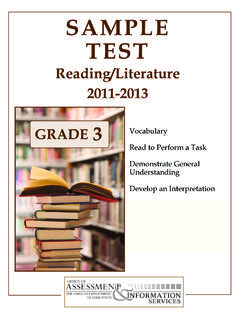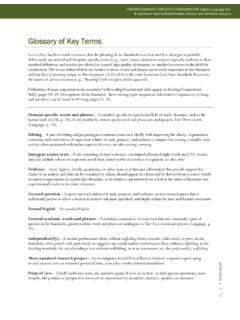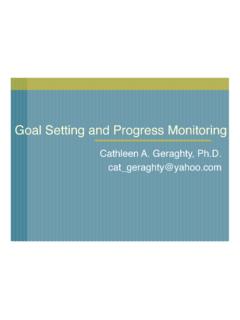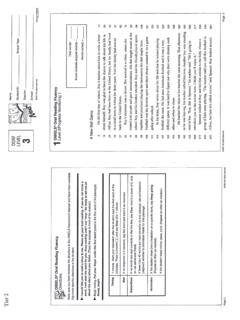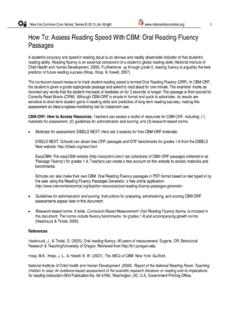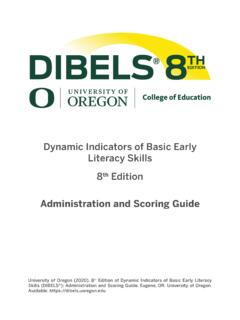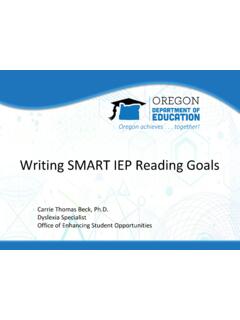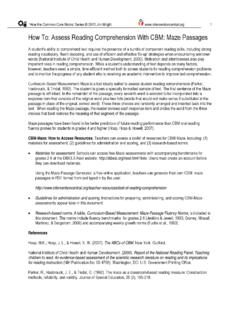Transcription of Patterns of Strengths and in L.D. Identification
1 9/23/2013. Patterns of Strengths and Weaknesses in Identification October 3, 2013. Jody Conrad, , School Psychologist, SOESD. Definitions of SLD. Federal and State A disorder in one or more basic psychological processes involved in understanding and using language spoken or written, which may manifest itself as the imperfect ability to listen, think, speak, read, write, or do math calculations.. A disorder in one or more of the basic psychological processes involved in understanding or in using language, spoken or written, which may manifest itself in an imperfect ability to listen, think, speak, read, write, spell or do mathematical calculations.
2 Specific learning disability includes conditions such as perceptual disabilities, brain injury, dyslexia, minimal brain dysfunction, and developmental aphasia. The term does not include learning problems that are primarily the result of visual, hearing, or motor disabilities, mental retardation, emotional disturbance, or environmental, cultural, or economic disadvantage.. 1. 9/23/2013. In Oregon . Districts may use two models for identifying students with SLD but the Department of Education does not give much specific guidance beyond that. 1) Response to Intervention 2) Patterns of Strengths and Weaknesses What is a SLD? A measureable skill deficit that: Is inherent to the individual Is of neurological origin Impacts specific cognitive skills whereby students have generally average or better overall cognitive ability Is unexpected or not readily explained Results in poor learning skill acquisition Results in an uneven pattern of learning 2.
3 9/23/2013. Basic Underlying Premises for SLD Identification 1) Good core instruction with universal screening 2) Additional interventions for those identified as being at risk for academic failure; more frequent progress monitoring for these students 3) A comprehensive evaluation occurs if the student does not respond at step 2. Assessments Required for SLD. An assessment of the child's academic achievement toward Oregon grade level standards A review of cumulative records, previous IEPs or IFSPs and teacher collected work samples Observation. An observation of the child in the child's learning environment (including the regular classroom setting) to document the child's academic performance and behavior in the areas of difficulty, which must consist of: (A) Information from an observation by a qualified professional in routine classroom instruction and monitoring of the child's performance before the child was referred for an evaluation.
4 Or (B) An observation conducted by a qualified professional (who is a member of the evaluation team) of the child's academic performance in a regular classroom after the child has been referred for an evaluation and parent consent obtained; or (C) For a child who is less than school age or out of school, an observation in an age . appropriate environment progress monitoring data, including: (A) Data that demonstrate that before, or as part of, the referral process, the child was provided appropriate instruction in regular education settings, delivered by qualified personnel; and (B) Data based documentation of repeated assessments of achievement at reasonable intervals, reflecting formal assessment of student progress that is directly linked to instruction 3.
5 9/23/2013. Regulations Specific to PSW. For a student evaluated using a model that is based on the student's Strengths and weaknesses, the evaluation must include an assessment of the student's Strengths and weaknesses in classroom performance and academic achievement, relative to age, Oregon grade level standards, or intellectual development If needed, a developmental history If needed, an assessment of cognition, fine motor, perceptual motor, communication, social or emotional, and perception or memory if the child exhibits impairment in one or more these areas If needed, a medical statement or health assessment indicating whether there are any physical factors that may be affecting the child's educational performance, and Any other assessments required to determine the impact of the suspected disability on the child's educational performance for a school age child or on the child's developmental progress for a preschool child The PSW Model A brain based model with ties to neuroscience Grounded in Cattell Horn Carroll (CHC) theory/research An attempt to identify Strengths and weaknesses, both academic and cognitive, wherein these Strengths /weaknesses are associated.
6 Identification of a convergence of data points among measures The application is known as cross battery assessment or XBA approach General Principles: 1) The full scale score is largely irrelevant 2) Most academic skills and cognitive abilities are in the average range with isolated weaknesses in academic and cognitive functioning 3) There is a match between a specific cognitive weakness to the specific area of academic concern 4) Most cognitive abilities that do not relate to the academic concern are average or above 4. 9/23/2013. Psychological Processes Brain processes, operations, or functions where information is perceived, transformed, manipulated, stored, retrieved, and expressed Provides the basis for learning Deficits in one or more of these processes create roadblocks to learning Interventions may fail because the processing deficit is not understood or addressed Nine Psychological Processes Memory short term, long term, working memory, retrieval fluency .
7 Includes both visual and auditory memory Attention selective attention, sustained attention, attention shifting, response inhibition Processing processing speed, automaticity, rapid decision making Language Use expressive and receptive language, listening comprehension, vocabulary development, general knowledge Mental Control executive functioning including planning, organizing, monitoring , also self regulation skills Problem solving/Judgment reasoning, decision making, social awareness Motor visual motor integration, motor speed, fine and gross motor skills Visual Processing spatial awareness, visual perception, perceptual organization Auditory Processing phonemic awareness, auditory perception, sound discrimination 5.
8 9/23/2013. Cognitive Processes Associated with Areas of Identification under SLD. Basic reading Skills memory, processing (speed), auditory processing, language use reading fluency memory, processing (speed), mental control, attention reading Comprehension memory, auditory processing, mental control, problem solving, language use Math Calculation memory, processing (speed), problem solving, visual processing, attention Math Problem Solving memory, processing (speed), mental control, problem solving, language use, visual processing Written Expression memory, processing (speed), auditory processing, mental control, problem solving, language use, motor oral Expression language use Listening Comprehension language use Broad and Narrow CHC Ability Representation in Intelligence Testing Gf Fluid Intelligence: Wechsler scales, Woodcock Johnson III.
9 Cognitive, Stanford Binet 5, DAS II, KABC II. Gc Crystallized Intelligence: Wechsler scales, Woodcock Johnson III. Cognitive, Stanford Binet 5, DAS II, KABC II. Gv Visual Processing: Wechsler scales, Woodcock Johnson III. Cognitive, Stanford Binet 5, DAS II, KABC II. Gsm Short Term Memory: Wechsler scales (except WPPSI IV), Woodcock Johnson III Cognitive, Stanford Binet 5, DAS II, KABC II. Glr Long Term Retrieval: Woodcock Johnson III Cognitive, DAS II, KABC II. Ga Auditory Processing: Woodcock Johnson III Cognitive, DAS II. Gs Processing Speed: Wechsler Scales, Woodcock Johnson III. Cognitive, DAS II. 6. 9/23/2013. Cognitive Abilities Important for Achievement in reading reading Achievement is tied to: Gc crystallized intelligence Ga auditory processing Glr long term retrieval Gsm short term memory Gs processing speed To a lesser extent: Gf fluid intelligence Gv visual processing Also neuropsychological processes including attention and executive function Cognitive Abilities Important for Achievement in Math Math Achievement is tied to.
10 Gf fluid reasoning Gv visual processing Gc crystalized intelligence Gsm short term memory Glr long term retrieval Gs processing speed Also neuropsychological processes including attention and executive function 7. 9/23/2013. Cognitive Abilities Important for Achievement in Writing Writing Achievement is tied to: Gc crystallized intelligence Ga auditory processing Gsm short term memory Gs processing speed Also orthographic processing, visual motor integration, attention, and executive functions Data Points to Consider File review with history of concern and attendance Observation on/off task, organizational skills, need for additional directions, work completion rates progress monitoring starting point and rate of progress compared to peers ( dibels ).

